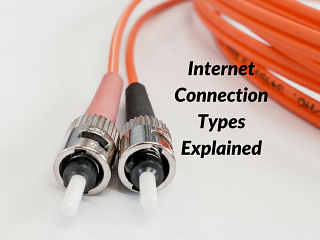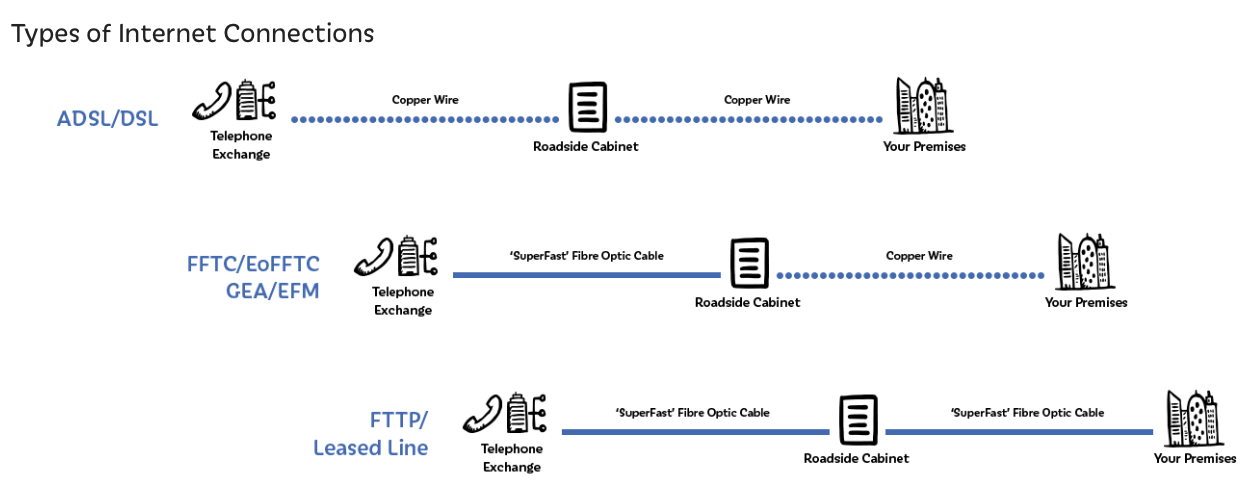 A high-speed internet connection is a necessity for both homes and businesses alike, but as technology has evolved the variants in solutions has become mind-boggling.
A high-speed internet connection is a necessity for both homes and businesses alike, but as technology has evolved the variants in solutions has become mind-boggling.
Have ever struggled to tell the various types apart….?
Or have you been confused about what the differences are….?
Then read on, because this guide is for you!
1) ADSL – Asymmetric Digital Subscriber Line is one of the most common broadband services in the UK and most homes have an ADSL connection. It uses the copper lines of the BT phone network, but unlike dial-up it allows you to make phone calls at the same time as using the internet. Asymmetric refers to the fact that it has substantially greater download speeds than upload.
Our Business Broadband service offers speeds of: download 24 Mbps / upload 8 Mbps
2) FTTC – Fibre to the Cabinet runs along fibre optic cables to the street cabinets and then over the existing copper wires to home and business premises. This replacement of a large portion of copper cables with the more modern fibre optic cables gives a substantial speed boost.
FTTC is now available to over 26m premises in the UK, and Openreach’s nationwide rollout is helping the government’s target of reaching 95% of UK premises by the end of 2017.
Check here to see if it is available in your area!
Our Business Fibre Broadband offers speeds of: download up to 76 Mbps & upload up to 19 Mbps
3) EoFTTC – Ethernet over Fibre To The Cabinet is the next generation of FTTC where users have their own dedicated line (known as uncontended) from the cabinet so there is no sharing with neighbouring homes & businesses. This means they will have constant bandwidth and won’t see service degradation even at peak times.
4) GEA – Generic Ethernet Access is similar to FTTC in that it uses copper wires from the cabinet to the premises, but unlike FTTC it runs over Ethernet from the cabinet to the exchange. Offers the benefits of an Ethernet connection with lower costs.
5) EFM – Ethernet in the First Mile uses multiple copper wires where fibre is not available, and refers to the network connection between a home or premises and the first street pole, cabinet or office owned by the broadband provider.
6) FTTP – Fibre To The Premises as it’s name suggests, FTTP bypasses all copper to deliver broadband direct from the local exchange to your door, running on specially laid fibre cables and providing increased speeds
7) Ethernet Fibre uses fibre to connect directly to the telephone exchange, so does not connect via a street cabinet.
8) Leased Line is the term used to describe a dedicated ‘pipe’ running between your premises and the local exchange to provide any of the above services.
Our Direct Internet Access solution covers all of the services mentioned above. It is a bespoke offering that takes into account individual needs and requirements as well as the available infrastructure. The key benefits include symmetric download/upload speeds, uncontended bandwidth and the fact that multiple users can be online at the same time.
To talk to us about what would work best for your business, contact our experts, who will be happy to talk you through the options we offer.

 Unresponsive or stuttering WiFi is one of the most frustrating problems of the modern age, but there are several things you can do for little or no cost to try and improve your speed.
Unresponsive or stuttering WiFi is one of the most frustrating problems of the modern age, but there are several things you can do for little or no cost to try and improve your speed.









